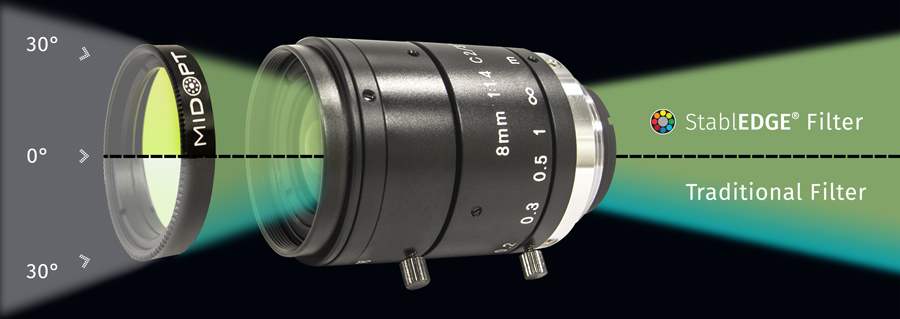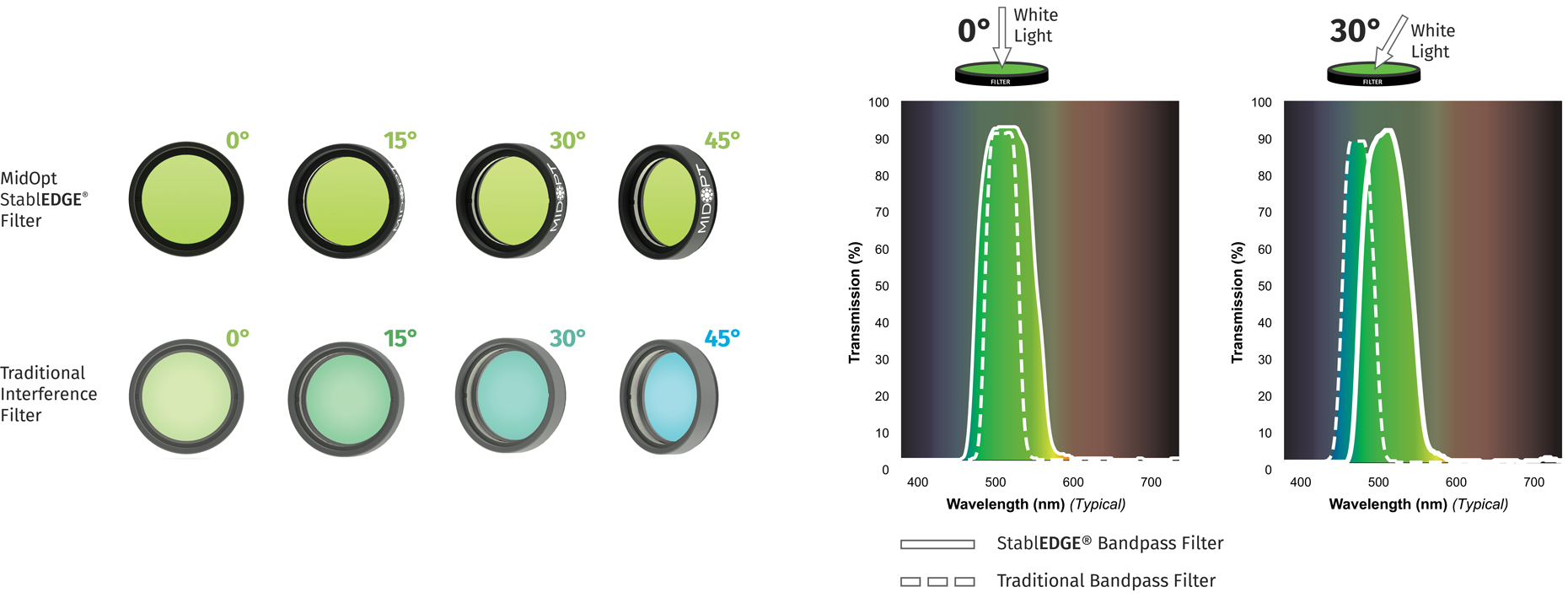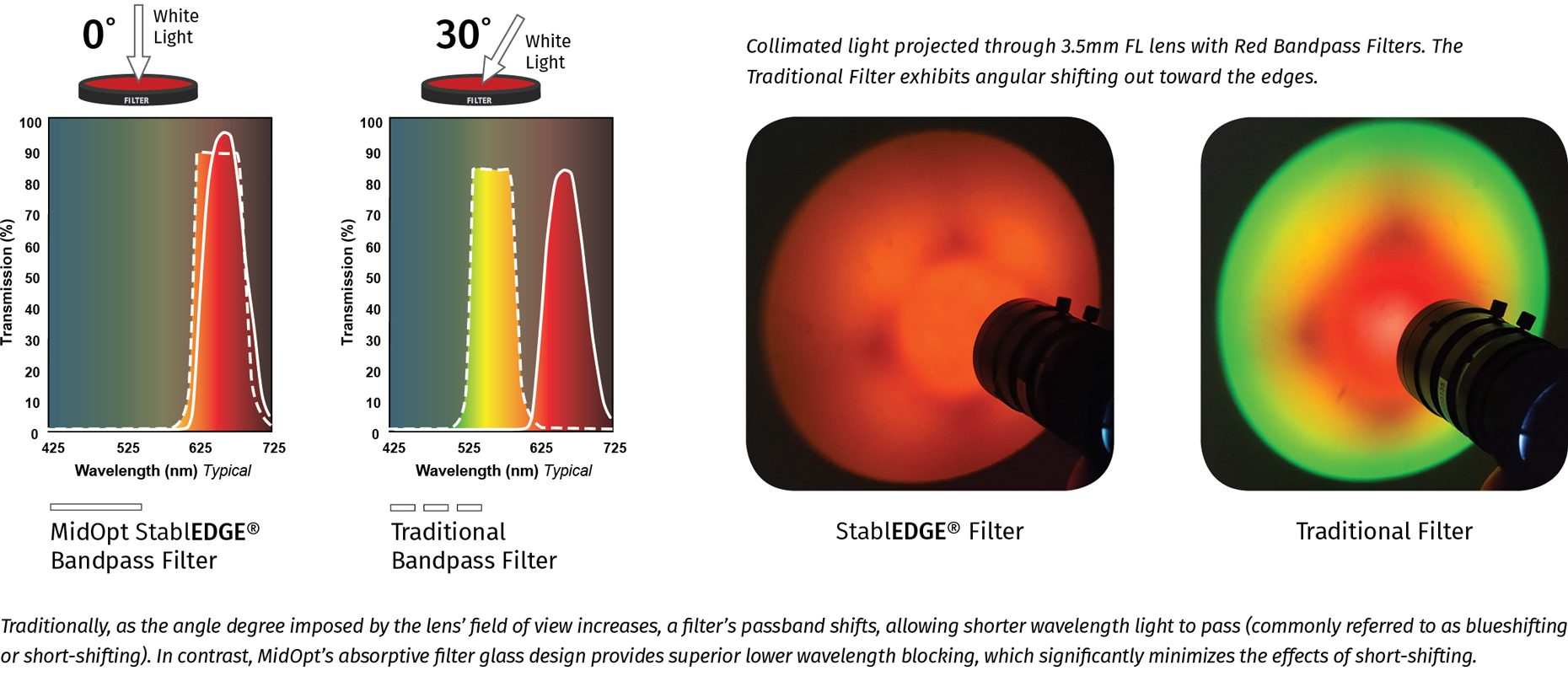StablEDGE® filter design
Superior Wavelength Control
at Any Angle
Filter Design
Minimize the Effects of Short Shifting
MidOpt StablEDGE® optical filters are specifically designed to be less susceptible to effects from angular shifting seen when optical filters are placed in front of short focal length (<12mm) camera lenses.
This feature is becoming increasingly important as today’s trend in machine vision imaging progresses toward more compact inspection layouts, which utilize less space and force the camera and lens closer to the subject. As a result, short focal length lenses are now more widely used than ever before.
Using a traditional coated interference filter in these more compressed configurations results in contrast loss toward the edges of the image. Because of the angle imposed by the field of view (FOV) of the lens, the passband shifts and allows short wavelength ambient light to overwhelm the subject. Light from LED or laser diode lighting is also cut off. In contrast, peak transmission of MidOpt StablEDGE® filters is not significantly altered, and effects due to short shifting are minimized.

 StablEDGE® filters take advantage of absorptive filter glass to form the leading edge of the filter passband. This assures no shifting in this region, even when the lens FOV exceeds 100 degrees. Filter glass also offers superior lower wavelength blocking of ambient light, sharp transition slopes and unmatched durability.
StablEDGE® filters take advantage of absorptive filter glass to form the leading edge of the filter passband. This assures no shifting in this region, even when the lens FOV exceeds 100 degrees. Filter glass also offers superior lower wavelength blocking of ambient light, sharp transition slopes and unmatched durability.
MidOpt StablEDGE® filter cut-off slopes utilize interference filter coatings; however, the cut-off slope is positioned to be sufficiently broad, and the Gaussian passband profile ensures that excessive ambient light is not allowed to degrade image contrast. Thus, shifting will not significantly encroach into peak transmission, assuring angular insensitivity over the desired range.

Shown above, a monochrome camera with a 6mm focal length lens looks at a red laser diode-generated line in a darkened room. When a StablEDGE® bandpass filter is used, the entire line is visible. When a traditional bandpass filter is used, only the center of the line is visible. The angular field of view (FOV) imposed by the lens causes the outer portion of the filter to “short shift.”
In the color photos below, when white light is projected through a lens and traditional filter then imaged with a color camera, only green and orange light are seen at the edges of the projected circle. The StablEDGE® filter exhibits little change, and the projected circle appears red. However, when red laser light is imaged with a monochrome camera, there is no longer any orange or green component to the light. Therefore, with a traditional bandpass filter, the white line simply disappears at the edges.
 Among all machine vision filter manufacturers, MidOpt is unique in incorporating StablEDGE® technology across a full range of products. StablEDGE® designs are less angle-of-incidence sensitive, are inherently more rugged, are environmentally stable, and can be found in the MidOpt BP and BN (Bandpass) series; AC (Acrylic) series; LA, LB and FL (Light Balancing) series; SP (Shortpass) series; and LP (Longpass) series filters. –
Among all machine vision filter manufacturers, MidOpt is unique in incorporating StablEDGE® technology across a full range of products. StablEDGE® designs are less angle-of-incidence sensitive, are inherently more rugged, are environmentally stable, and can be found in the MidOpt BP and BN (Bandpass) series; AC (Acrylic) series; LA, LB and FL (Light Balancing) series; SP (Shortpass) series; and LP (Longpass) series filters. –
› Download StablEDGE® Filter Overview
› View all MidOpt Filters

